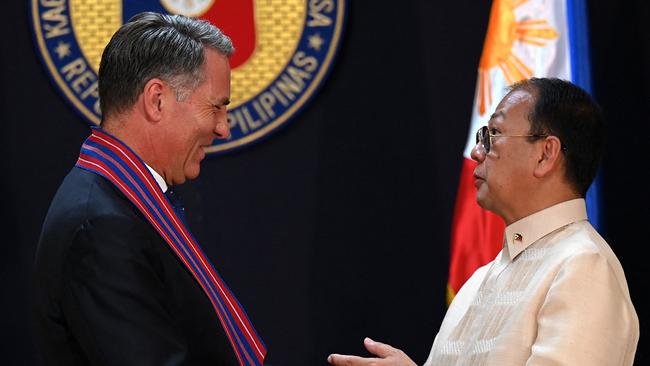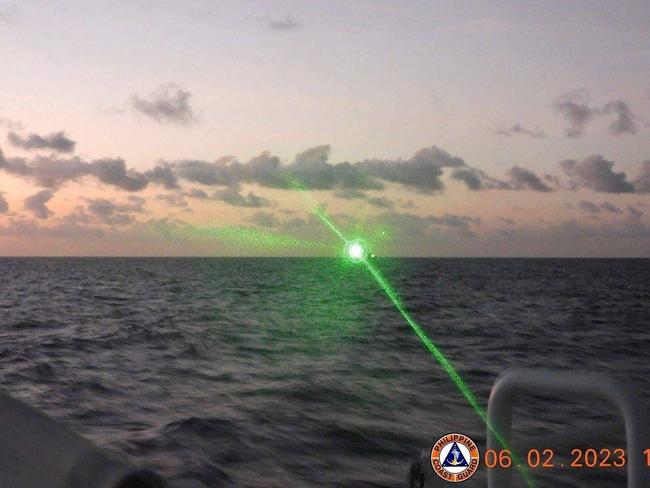Australia joins the Philippines in move against China
Australia is making a big move in the South China Sea after a Coastguard crew were blinded by a Chinese laser.

World
Don't miss out on the headlines from World. Followed categories will be added to My News.
Minister of Defence Richard Marles revealed Australia and the Philippines were in early talks to hold joint patrols of the South China Sea.
During a visit to the archipelago, Mr Marles and his Filipino counterpart Carlito Galvez Jr discussed expanding defence co-operation, which is currently Army-focused to counter terrorism in Mindanao, to include the Navy and Air Force in the South China Sea.
It comes after a Chinese coast guard used a military-grade laser to blind the Filipino crew of a patrol near a disputed shoal. The act that moved the nation closer to the United States, which also vowed to begin joint patrols in the region.
“As countries which are committed to the global rules-based order it is natural that we should think about ways that we should co-operate in this respect,” Mr Marles said at a joint press conference.
“And so we did talk today about the possibility of exploring joint patrols and we will continue that work, and we hope that comes to fruition soon.”

The Australian involvement in the South China Sea echoes similar discussions the Philippines had with US Defence Secretary Lloyd Austin after Beijing’s escalation.
Mr Galvez said the Philippines have previously conducted joint Navy and Air Force patrols which they would like to see replicated for “more intensive” co-operation with Australia.
“We have the experience, and we can do it again,” he said.
“On behalf of the Philippine government, really thank the generosity and the dedication … to make sure Australia will become responsible, relevant to our counter-terrorism and also maritime security affairs,” he added.
Mr Marles, visiting Camp Aguinaldo in Quezon City, said there has been continued “growth in the complexity” of the military exercises held between the two countries, and that they were actively discussing how to do more focused on the “law of the sea”.
“We hope this really blossoms into a much bigger defence-to-defence relationship between our two countries, which does seek to build our collective security and which does seek to help contribute to upholding the rules-based order in our region,” Mr Marles said.
“We’re both countries who are deeply invested in asserting the UN Convention on the Law of the Sea, throughout the world, but in places like the South China Sea, where most of Australia’s trade traverses.”
The 1982 United Nations Convention of the Law of the Sea is the legal framework defining the navigation, use, and protection of the marine environment between countries.
Manila accused a Chinese ship of blocking one of their patrol vessels from approaching the submerged reef, Second Thomas Shoal, which falls within the Philippines’ 321km exclusive economic zone, earlier this month.
Mr Marles’ US counterpart told the Philippines last week that Washington would “deepen operational co-operation”, including joint patrols, after the February 6 clash in the South China Sea.
Philippine President Ferdinand Marcos summoned the Chinese Ambassador to express his serious concern over “the increasing frequency and intensity of actions” by China against his country’s Coast Guard and fishermen.


Beijing’s Foreign Ministry spokesman Wang Wenbin claimed China has “indisputable sovereignty over the Nansha Islands, including the Ren’ai Reef”, using local nomenclature for the disputed island chain.
“A Philippine Coast Guard vessel intruded into the waters adjacent to the Ren’ai Reef without Chinese permission. The China Coast Guard ship was compelled to respond in accordance with law and warned the vessel to leave the area,” he said.
“During that process, the China Coast Guard ship used a handheld laser speed detector and handheld green light pointer to measure the distance and speed of the Philippine vessel and signal directions to ensure navigation safety.”





